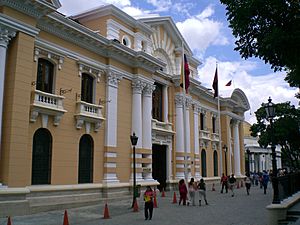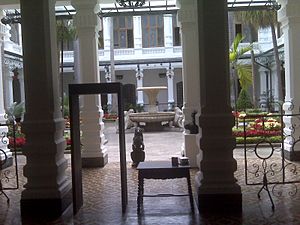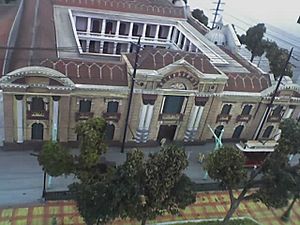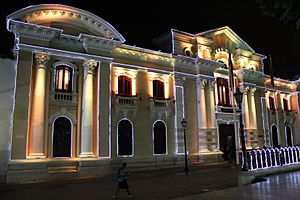Palacio Municipal de Caracas facts for kids
The Palacio Municipal de Caracas, also known as the Caracas City Hall, is an important building in Caracas, Venezuela. It serves as the main office for the city's local government. You can find it right across from Plaza Bolívar, a famous square in the city.
This building has a long history, dating back to the 1600s. It looks quite grand today, thanks to changes made in 1906 by architect Alejandro Chataing. The Palacio Municipal is famous because it was where Venezuela's Declaration of Independence was signed on July 5, 1811. This is why it's often called the "cradle of independence." Inside, there's also the Museo Caracas, a museum filled with art and historical items. The building became a National Historic Landmark in 1979.
Contents
History of the Caracas City Hall
The story of the Palacio Municipal began in 1673. At that time, a man named Antonio Gonzáles de Acuña bought several buildings. He turned them into a school for religious studies called the Colegio Seminario de Santa Rosa de Lima. This was the first seminary in the area during the 17th century.
Over time, this seminary grew into a place for higher education. In 1725, it became the Real y Pontificia Universidad de Caracas. Later, in 1810, it was renamed the Universidad de Los Andes. Eventually, Simón Bolívar changed its name again to Universidad Central de Venezuela.
Key Moments and Renovations
In 1872, President Antonio Guzmán Blanco had the building renovated. It was then used as the Palacio de Justicia, which means the Supreme Court of Venezuela. More changes were made between 1904 and 1906. President Cipriano Castro asked architect Alejandro Chataing to lead these updates.
The Palacio Municipal played a big role in Venezuela's history. It was the place where the country's independence was declared in 1811. This event happened in the Capilla de Santa Rosa de Lima, a chapel inside the building. This chapel has been carefully restored to look like it did back then.
In 1979, the building was officially recognized as a national monument. More recently, after elections in 2008, a group of people took over the building. They caused some damage to the outside and the mayor had to work from a different location for a while.
Architecture of the Building
The building you see today is mostly the result of Alejandro Chataing's work in 1906. It stands on the corner of Gradillas a Monjas, directly across from Plaza Bolívar. It takes up half of the southern side of the plaza.
The Palacio Municipal is built in a style called Neoclassical. This style often uses elements from ancient Greek and Roman buildings. The main front of the building has three floors. The main entrance has double pillars on each side. Above the entrance, there's a balcony with a triangular top part, similar to old temples. The side of the building also has pillars that look like those found in ancient Roman buildings. Inside, the large building has a beautiful, elegant patio.
The Caracas Museum
The Museo Caracas, sometimes called Museo Santana or Museo Crillo, is located on the ground floor of the Palacio Municipal. This museum displays about 3,000 items that are important for art or history.
What You Can See in the Museum
- Room 2: Here you can see paintings of two important Venezuelan presidents. One is Joaquín Crespo, painted by Arturo Michelena. The other is José Tadeo Monagas, painted by Martín Tovar y Tovar.
- Room 3: This room features many small, carved figures made by Santana. These figures represent famous Venezuelan people from the early 1900s.
- Room 4: You'll find flags and banners here, including one from 1533. This flag belonged to the Spanish explorer Francisco Pizarro. General Antonio José de Sucre gave it to Bolívar after Venezuela became free from Spanish rule.
- Room 5: This room showcases paintings by famous Venezuelan artists. Some of these artists include Armando Reverón, Emilio Boggio, Rafael Monasterios, Federico Brandt, and Manuel Cabré. You can also see small paintings of country scenes by Raul Santana. Look up, and you'll see a painting on the ceiling that shows Bolívar in the sky.
See also
 In Spanish: Palacio Municipal de Caracas para niños
In Spanish: Palacio Municipal de Caracas para niños





